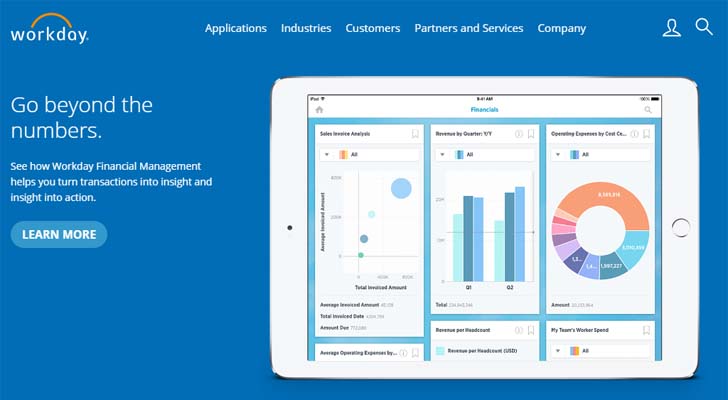Workday (NASDAQ:WDAY) had quite a year on the markets gaining 57% in 2018; it’s up more than 4% year to date through Jan. 17, which suggests Workday stock is on its way to a third consecutive year of significant gains since going public at $28 in October 2012.
Currently trading at 14 times sales, it would be an expensive acquisition for any potential suitors including Microsoft (NASDAQ:MSFT), whose last significant acquisition was its $26.2 billion purchase of LinkedIn in 2016; itself a pricey nine times sales.
Despite the daunting idea of paying such a big price for a company with just $2.6 billion in TTM revenue and an operating loss of $424 million, here are three reasons why it makes sense for Microsoft to pull the trigger.
Workday Stock and Big HR
If you’re unfamiliar with Workday’s business and business model, it provides cloud-based software human resources and accounting departments for medium- to large-sized companies around the world including 50% of the Fortune 50.
It makes money on a subscription basis with companies typically signing contracts of three years or longer with the fees based on the number of employees.
In fiscal 2018, it had revenues of $1.8 billion. In 2012, the year it went public, it had annual revenue of $134.4 million, a yearly growth rate of 54%.
Workday estimates the worldwide human capital management software industry is an $18 billion market, expected to grow to $24 billion by 2022. More important, the company believes that the company’s total addressable market is five times the HCM market if you include payroll, financial, analytics, and planning opportunities in a calculation of its growth potential. That could be huge for Workday stock.
As for Microsoft, it has Dynamics, a customer relationship management (CRM) software business that generates approximately $2.5 billion annually. Buying Workday would make it a more formidable competitor in the CRM field while also giving it access to one of the hottest segments of the software industry.
Workday Stock and Cloud Expertise
Microsoft is the world’s largest commercial cloud company with an annual run rate of $21.2 billion, approximately $800 million ahead of second place Amazon (NASDAQ:AMZN) and double IBM (NYSE:IBM) in a distant third position.
There’s no question Microsoft’s dominant position in the cloud would provide Workday with the resources it needs to keep growing at 50% or more each year.
“Microsoft has talked about its large ambitions in business apps, but we note that Dynamics has around $2.5 billion run-rate revenue vs. applications product revenue of $20 billion at SAP (NYSE:SAP), $13 billion at
Salesforce (NYSE:CRM), and $11 billion at Oracle (NYSE:ORCL),” RBC Capital Markets analyst Matthew Hedberg said in a recent report. “Furthermore, by acquiring Workday, Microsoft would add another asset that can heavily leverage the Azure cloud infrastructure.”
Microsoft has $32 billion in free cash flow to make this deal happen.
Certainly, there are other cheaper alternatives to WDAY stock such as Ceridian HCM (NYSE:CDAY), a company whose stock I recommended in May, in large part because of its CEO, David Ossip, who’s done a masterful job growing its business.
However, Ceridian HCM’s annual revenue is one-third Workday’s; it wouldn’t deliver as much of a boost to Microsoft’s top- and bottom line, not to mention its trajectory of growth.
Workday Stock and LinkedIn
Were Microsoft to gobble up Workday, it would become the largest acquisition in the company’s storied history.
Acquisitions of any size are tough to make work because the synergies and savings projected often don’t materialize. In addition, the merging of cultures fails to click, creating a situation where 1 + 1 = 1.5 rather than 3. The larger the acquisition, the more likely these two conditions come into play.
In other words, every deal’s odds of going south is higher than you might think. Investors felt that way about LinkedIn back in 2016.
Here’s just one example:
“Let’s put aside the fact that this is almost four times as much as the company paid for its dismal Nokia deal,” wrote VentureBeat contributor Chris O’Brien in June 2016. “Microsoft bought Yammer in 2012 for $1.2 billion and Skype before that for $8.5 billion. How many enterprise-type communication platforms does one company need?”
Plenty.
In December, InvestorPlace’s James Brumley discussed LinkedIn’s integration with Office 365, providing insight into the many ways Microsoft is adding value for its users.
“Office 365 subscribers and LinkedIn users are likely to be well-aware of the fact that the two platforms now work as one,” Brumley wrote Dec. 17. “The company’s Outlook e-mail software seamlessly connects with LinkedIn’s data, giving LinkedIn’s users quick and easy access to their Outlook contacts. The connection even allows LinkedIn users to collaborate on Office 365 documents.”
Microsoft’s figured out how to integrate apps and platforms into its existing business. Adding WorkDay to the mix shouldn’t be too difficult given its experience with LinkedIn.
Lessons learned.
As of this writing, Will Ashworth did not hold a position in any of the aforementioned securities.

